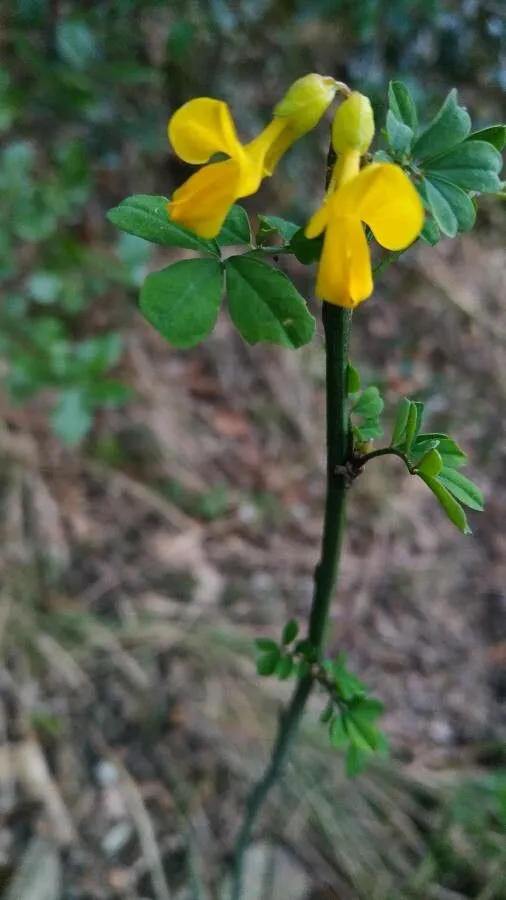
Author: (L.) Lassen
Bibliography: Svensk Bot. Tidskr. 83: 86 (1989)
Year: 1989
Status: accepted
Rank: species
Genus: Hippocrepis
Vegetable: False
Observations: Europe to Caucasus, Medit.
Scorpion-senna, scientifically known as Hippocrepis emerus, is a fascinating member of the Fabaceae family. This perennial plant is notable for its wide geographical distribution, ranging from Europe all the way to the Caucasus region, and extending to the Mediterranean area.
Hippocrepis emerus showcases the exceptional adaptability and resilience typical of many Fabaceae family members. The plant thrives in a variety of climates and terrains, demonstrating its ability to flourish in diverse environmental conditions. Whether nestled in rocky Mediterranean slopes or spread across temperate European woodlands, the Scorpion-senna exemplifies versatility in its habitat choices.
This species is distinguished by its distinctive morphology. The plant often exhibits a shrubby growth form, which can vary in size but generally remains within the small to medium range. Its leaves are pinnate, adding to the aesthetic appeal with an arrangement that is both intricate and visually pleasing. One of the key recognizable features of Scorpion-senna is its uniquely shaped pods, which are reminiscent of a scorpion’s tail—a trait that likely inspired its common name.
The vibrant yellow flowers of Hippocrepis emerus emerge in clusters, providing a striking contrast against the green foliage. Not only do these blossoms add a splash of color to the landscapes they inhabit, but they also play a critical role in the local ecosystem. The flowers are known to attract various pollinators, including bees, which are essential for the propagation of many plant species within their habitats.
The Scorpion-senna’s inclusion in botanical literature highlights its significance. Notably, it was discussed in depth in the 1989 publication of the Svensk Botanisk Tidskrift (Swedish Botanical Journal), where its various attributes and botanical characteristics were outlined by esteemed botanist Lassen, contributing greatly to the scientific understanding and appreciation of this species.
In conclusion, Hippocrepis emerus or Scorpion-senna is a notable plant not only for its distinctive physical characteristics and impressive adaptability but also for its ecological importance. The plant’s ability to thrive in varied environments from Europe to the Mediterranean underscores its versatility and resilience, making it a noteworthy subject of study and admiration within the botanical community.
Dan: perlebælg
Eng: scorpion senna, scorpion-senna
Deu: strauch-kronwicke
Swe: gulkronill, guldkronill, gulkoronill
Ces: podkovka křovitá
Nld: struikpaardenhoefklaver
Cym: ffacbys pedol prysgwyddog, ffacbysen bedol brysgwyddog
En: Scorpion-senna, Scorpion Senna, Coronilla
Ar: حدوة الحصان الحدائقية
Az: Kolvari acıyonca
Ca: Coronil·la boscana
Zh: 蝎子旃那
Hr: Gluhovet
Cs: Čičorečka ladná, Čičorečka vratič, Podkovka křovitá
Da: Perlebælg
Nl: Struikpaardenhoefklaver, Kroonwikke, Struikkroonkruid, Struikpaardehoefklaver
Eo: Arbusta hipokrepo
Fi: Pensashevonpalko
Fr: Faux-sené, Coronille des jardins, Coronille arbrisseau, Coronille faux séné, Faux Séné, Faux Baguenaudier, Séné bâtard, Coronille émérus, Hippocrépide émérus, Coronille faux-séné
De: Strauch-Hufeisenklee, Strauchwicke, Strauch-Kronwicke, Bastardsenne, Kronwicke, Strauch Wicke, Strauchkronwicke
Hu: Bokros koronafürt
It: Cornetta dondolina, Dondolino, Emero, Erba-cornetta, Ginestra di bosco
Mk: Зајачковина
No: Buskvikke
Sk: Podkovka ľúba
Sv: Gulkronill, Guldkronill, Gulkoronill
Cy: Ffacbysen bedol brysgwyddog, Ffacbys Pedol Prysgwyddog
Taken Apr 15, 2019 by Manu Pacha (cc-by-sa)
Taken Apr 15, 2019 by Manu Pacha (cc-by-sa)
Taken Apr 18, 2019 by Manu Pacha (cc-by-sa)
Taken Apr 11, 2019 by Manu Pacha (cc-by-sa)
Taken Apr 11, 2019 by Manu Pacha (cc-by-sa)
Taken Apr 9, 2021 by Omur Rafa (cc-by-sa)
Taken May 20, 2021 by Emanuele Santarelli (cc-by-sa)
Taken Apr 10, 2022 by Florentinus (cc-by-sa)
Taken Jan 20, 2022 by cirse (cc-by-sa)
Taken Apr 11, 2019 by Manu Pacha (cc-by-sa)
Taken Jun 18, 2016 by Tela Botanica − Yoan MARTIN (cc-by-sa)
Taken Mar 26, 2017 by Yoan MARTIN (cc-by-sa)
Taken May 20, 2021 by Emanuele Santarelli (cc-by-sa)
Taken Jan 20, 2022 by cirse (cc-by-sa)
Taken Apr 7, 2021 by Aurélie D’huyvetter (cc-by-sa)
Taken Jun 18, 2016 by Tela Botanica − Yoan MARTIN (cc-by-sa)
Taken Apr 24, 2019 by Massimo D’Angelo (cc-by-sa)
Taken Sep 6, 2021 by bismilla (cc-by-sa)
Taken Jun 18, 2016 by Tela Botanica − Yoan MARTIN (cc-by-sa)
Taken Apr 27, 2012 by Tela Botanica − Yoan MARTIN (cc-by-sa)
Taken Oct 23, 2005 by Tela Botanica − Claire RIGOULAT (cc-by-sa)
Taken Apr 26, 2019 by Valova G (cc-by-sa)
Taken Mar 26, 2017 by Yoan MARTIN (cc-by-sa)
Taken May 30, 2021 by huy HO (cc-by-sa)
Taken Apr 6, 2014 by Tela Botanica − Jean-Luc Gorremans (cc-by-sa)
Taken Apr 21, 2016 by Tela Botanica − Liliane ROUBAUDI (cc-by-sa)
Taken Apr 21, 2016 by Tela Botanica − Liliane ROUBAUDI (cc-by-sa)
Taken Apr 21, 2016 by Tela Botanica − Liliane ROUBAUDI (cc-by-sa)
Taken Apr 21, 2016 by Tela Botanica − Liliane ROUBAUDI (cc-by-sa)
Taken Apr 21, 2016 by Tela Botanica − Liliane ROUBAUDI (cc-by-sa)
© copyright of the Board of Trustees of the Royal Botanic Gardens, Kew.
© copyright of the Board of Trustees of the Royal Botanic Gardens, Kew.
© copyright of the Board of Trustees of the Royal Botanic Gardens, Kew.
Growth habit: Shrub
Ph maximum: 8.0
Ph minimum: 7.5
Light: 7
Atmospheric humidity: 4
Bloom months: [‘apr’, ‘may’, ‘jun’]
Soil nutriments: 4
Family: Myrtaceae Author: (F.Muell.) K.D.Hill & L.A.S.Johnson Bibliography: Telopea 6: 402 (1995) Year: 1995 Status:…
Family: Rubiaceae Author: Pierre ex A.Froehner Bibliography: Notizbl. Bot. Gart. Berlin-Dahlem 1: 237 (1897) Year:…
Family: Sapindaceae Author: Koidz. Bibliography: J. Coll. Sci. Imp. Univ. Tokyo 32(1): 38 (1911) Year:…
Family: Asteraceae Author: A.Gray Bibliography: Pacif. Railr. Rep.: 107 (1857) Year: 1857 Status: accepted Rank:…
Family: Fabaceae Author: Medik. Bibliography: Vorles. Churpfälz. Phys.-Ökon. Ges. 2: 398 (1787) Year: 1787 Status:…
Family: Aspleniaceae Author: (Cav.) Alston Bibliography: Bull. Misc. Inform. Kew 1932: 309 (1932) Year: 1932…